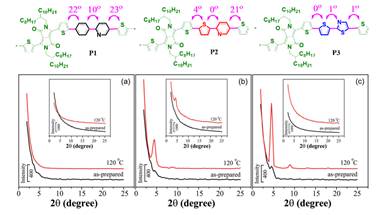Since the first organic field effect transistor (OFET) based on polythiophene was reported in 1986, organic conjugated semiconducting polymers and their thin film OFETs have been attracted extensive attentions. In the past decade, the thin film OFETs with D-A type organic conjugated polymers have made rapid developments and widespread applications in the field of flexible active-matrix displays, radio frequency identification tags, gas sensors, and so on. As the key part of OFET device, the structures and opto-electronic performances of organic conjugated polymers are particularly important. A large number of excellent polymeric semiconducting materials have been explored and applied successfully in OFET devices. Zhang et al. (Institute of Chemistry, Chinese Academy of Sciences) mainly focused on the “structure-property” relationships of conjugated polymers. Recently, they introduced three novel DPP-based polymers through fine-tuning the structures of conjugated backbone. The results of calculations and UV-vis spectra demonstrated that the structures of polymers have remarkable influences on energy levels, molecular conformations, and on OFET performances, which is published on September 6th, 2016 in Journal of Materials Chemistry C (2016, 4, 9359-9365.).
They have studied the packing mode of polymers on the thin films by using GIXRD from 1W1A, Beijing Synchrotron Radiation Facility. They find that polymer P3 with planar conjugated backbone exhibits intense signals and edge-on intermolecular arrangements, whereas the other two polymers are poorly orientated and even amorphous. This could explain higher mobility is obtained for P3 than others. This study demonstrates that charge mobilities of polymer thin films can be improved with less twisting conjugated backbones.Article: Jibin Sun, Zitong Liu,* Hewei Luo, Sifen Yang, Jingjing Yao, Guanxin Zhang, Deqing Zhang*, The adjustment of bandgap and coplanarity of diketopyrrolopyrrole-based copolymers through fine-tuning of the conjugated backbones and applications in thin film field effect transistors. J. Mater. Chem. C, 2016, 4, 9359-9365. |


